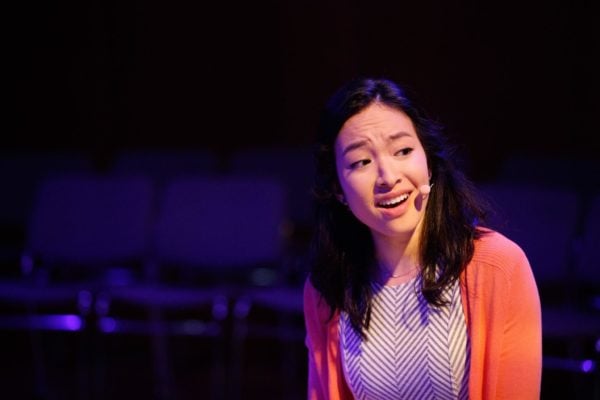
Over the weekend, the Stanford Asian American Theater Project (AATP) presented “The Last Five Years,” a contemporary musical written by Jason Robert Brown, directed by Zoë Sonnenberg ‘18. “The Last Five Years” offers its audience a glimpse into the lives, minds and romance of Jamie Wellerstein and Cathy Hiatt. The story follows Jamie through the start of his relationship with Cathy, moving forward in time, while it follows Cathy after their relationship has ended, moving backwards. When the play begins, in the opening numbers, Cathy is lamenting the end of the relationship while Jamie is gushing over seeing Cathy for the first time, thinking aloud, “I think that I could be in love with someone like [her].”
The show was staged in a modestly sized venue, the Elliott Program Center, creating an intimate space for the performers and the audience to share. The seating and the stage were leveled with each other, contributing to the closeness. The only thing separating the performers from the audience was a circular frame made up of various sheets of papers (musical compositions — most in perfect condition, some crinkled, some browning, perhaps to signify the passage of time). The orchestra played in the corner, while hanging light bulbs rested in the air with their cords curled around the wooden ceiling joists like twining vines, accompanied by stage lights that shined magenta and deep blue hues.
The show features a rotating cast, switching between Maya Ganesan ‘19 and Audy Mulia ‘18 as Cathy and between Scott Kazmierowicz ‘18 and David Lorenzo Lopez ‘18 as Jamie. On Friday night, I watched Mulia and Lopez. The different embodiments of the characters allowed for different interpretations of the meaning of the play, not just by the performers, but by the audience as well. One consistency throughout the nights, however, is that the pairings were always interracial. In her director’s note, Sonnenberg writes about how this decision adds impact. Famous productions of the play, like the Chicago and Off-Broadway shows, as well as the film adaptation, starred white, same-race couples, but this version of “The Last Five Years” reimagines the characters, showing the universality of love and heartache, but also reemphasizing the couple’s struggles in understanding each other by highlighting their various and layered identities.
An interesting storytelling component of “The Last Five Years” is that the characters do not interact outside of when their narratives meet in the middle during their wedding, and this production highlights this beautifully. When Jamie sung “The Schmuel Song,” a song about a character in his newest story, as he prepared to present Cathy with her Christmas present, she wasn’t actually on stage. We, the audience, watched him sing to empty space, as if Cathy were there, sitting on a clear block. Especially with the set design, the production highlights the lack of effective communication between the couple, but it also reveals the limitedness of each person’s perspective. Getting inside their heads, experiencing Cathy and Jamie’s separate, but interwoven accounts of their relationship provides a clearer picture of the situation, and is also more accurate to real life. AATP’s “The Last Five Years” knows that, and doesn’t impose Jamie’s perception of Cathy or Cathy’s perception of Jamie upon the audience, but rather allows viewers to formulate their own ideas based off of how the characters see themselves.
The performances in “The Last Five Years” also drew me deeper into the story. When Lopez sang “Moving Too Fast,” a song about his recent good fortune with his book and with Cathy, I thought — he is unwaveringly happy, feeling as though the universe is conspiring in his favor. I’ve felt that. When Cathy sang “A Part of That,” a song about how Jamie sometimes prioritizes everything else, including their relationship, her voice slightly breaking as she delivered the line, “I’m a part of that, aren’t I?” I thought — she wants so badly to believe this thing is true, but she’s grappling with feelings of uncertainty. I’ve felt that, too.
AATP’s “The Last Five Years” is masterfully produced and acted, making for a moving, thought-provoking story about the ways in which love both builds and unmakes us, sometimes simultaneously. I left the venue, and as I biked home, I wondered about a few things: Does Cathy nearly become the girl she sings about not wanting to be? Are the characters in Jamie’s book himself and Cathy in the future he wished they had? Jamie sings about how “[he] could never rescue [Cathy]” — but was Cathy his for “saving”? In this version of “The Last Five Years,” there are no completely good or bad people. There is no way things should’ve ended. There are only decisions, which naturally produce an outcome, just like in real life.
Contact Chasity Hale at cah70352 ‘at’ stanford.edu.
